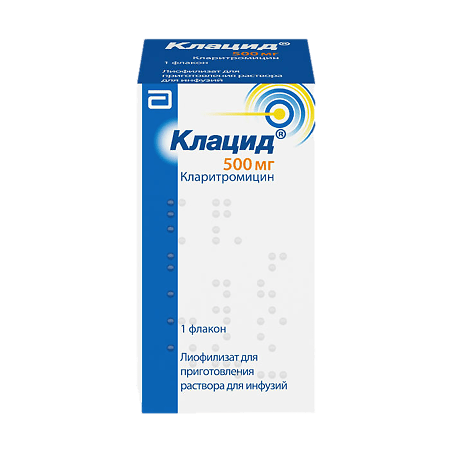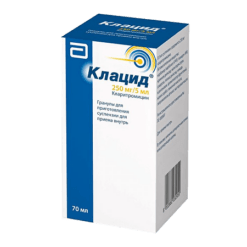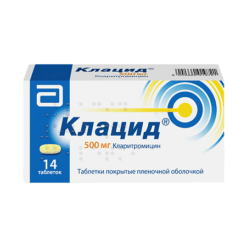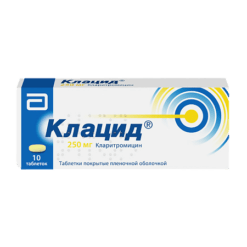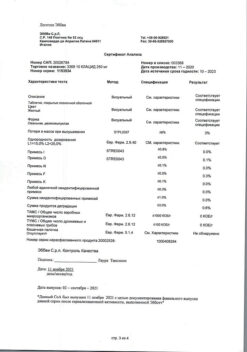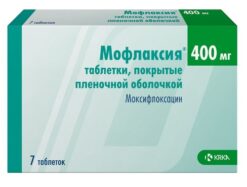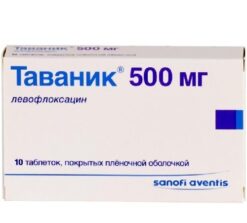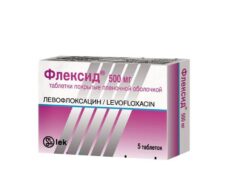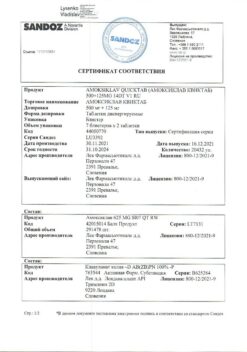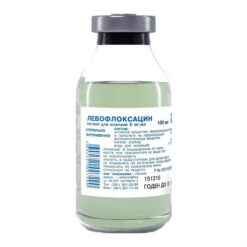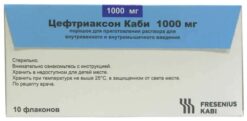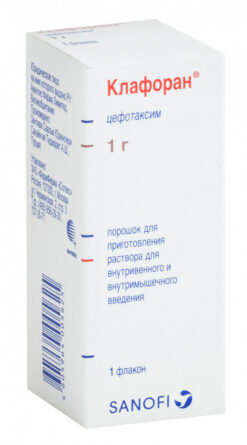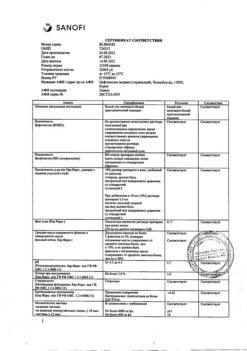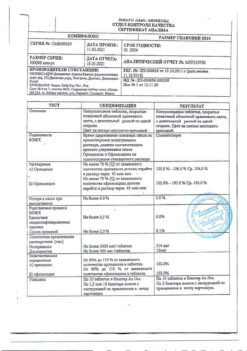No products in the cart.
Clacid, lyophilizate 500 mg
€1.00
Out of stock
(E-mail when Stock is available)
Description
Pharmacodynamics
Clarithromycin is a semi-synthetic antibiotic of macrolide group and has antibacterial effect by interacting with 50S ribosomal subunit of susceptible bacteria and inhibiting protein synthesis.
Clarithromycin has shown high in vitro activity against standard and isolated cultures of bacteria. It is highly effective against many aerobic and anaerobic gram-positive and gram-negative microorganisms. Clarithromycin in vitro is highly effective against Legionella pneumophila, Mycoplasma pneumoniae and Helicobacter (Campylobacter) pylori. Enterobacteriaceae and Pseudomonas as well as other non-lactose-degrading Gram-negative bacteria are not sensitive to clarithromycin.
Clarithromycin has been shown to have antibacterial activity against the following pathogens: aerobic Gram-positive microorganisms – Staphylococcus aureus, Streptococcus pneumoniae, Streptococcus pyogenes, Listeria monocytogenes. Aerobic Gram-negative microorganisms: Haemophilus influenzae, Haemophilus parainftuenzae, Moraxella catarrhalis, Neisseria gonorrhoeae, Legionella pneumophila; other microorganisms – Mycoplasma pneumoniae, Chlamydia pneumoniae (TWAR), Chlamydia trachomatis; Mycobacteria – Mycobacterium leprae, Mycobacterium kansasii, Mycobacterium chelonae, Mycobacterium fortuitum, Mycobacterium avium complex (MAC) – Mycobacterium avium, Mycobacterium intracellulare.
The production of beta-lactamase has no effect on clarithromycin activity. Most staphylococcal strains resistant to methicillin and oxacillin are also resistant to clarithromycin.
Helicobacter pylori. Sensitivity of H. pylori to clarithromycin was studied in H. pylori isolates isolated from 104 patients before the start of therapy with the drug. Clarithromycin-resistant H. pylori strains were isolated in 4 patients and 2 patients had strains with intermediate resistance; the remaining 98 patients’ H. pylori isolates were sensitive to clarithromycin.
Clarithromycin also has action in vitro against most strains of the following microorganisms (however, the safety and efficacy of clarithromycin in clinical practice has not been confirmed by clinical studies and the practical significance remains unclear) aerobic gram-positive microorganisms – Streptococcus agalactiae, Streptococci (groups C,F,G), Viridans group streptococci; aerobic gram-negative microorganisms – Bordetella pertussis, Pasteurella multocida; anaerobic Gram-positive microorganisms – Clostridium perfringens, Peptococcus niger, Propionibacterium acnes; anaerobic Gram-negative microorganisms – Bacteroides melaninogenicus; spirochetes – Borrelia burgdorferi, Treponema pallidum; Campylobacter – Campylobacter jejuni.
The main metabolite of clarithromycin in humans is the microbiologically active metabolite 14-OH-clarithromycin. The microbiological activity of the metabolite is the same as that of the parent substance, or 1-2 times weaker against most microorganisms. The exception is H. influenzae, against which the efficacy of the metabolite is 2 times higher. The starting substance and its main metabolite have either additive or synergistic effect against H. influenzae under in vitro and in vivo conditions depending on the bacterial culture.
Sensitivity studies
Quantitative methods requiring measurement of the diameter of the microbial growth retention zone provide the most accurate estimates of bacterial sensitivity to antimicrobial agents. One recommended sensitivity testing procedure uses discs soaked in 15 mcg of clarithromycin (Kirby-Bauer diffusion test) and interprets the test results as a function of the diameter of the stasis zone and the minimum suppressive concentration (MSC) of clarithromycin. The MPC value is determined by dilution of the medium or by diffusion into the agar. Laboratory tests give 1 out of 3 results:
1) resistant – it can be considered that the infection is not treatable with this drug;
2) moderately sensitive – the therapeutic effect is ambiguous and possibly increasing the dosage can lead to sensitivity;
3) sensitive – it can be considered that the infection is treatable with clarithromycin.
Pharmacokinetics
Healthy. In clinical trials in healthy volunteers, clarithromycin was administered once in doses of 75, 125, 250, and 500 mg in 100 mL as an infusion for 30 minutes and in doses of 500, 750, or 1000 mg in 250 mL for more than 60 minutes. The equilibrium Cmax of clarithromycin was 5.16 to 9.40 μg/mL after infusion of 500 and 1000 mg of clarithromycin for 60 min, respectively. The Cmax of 14-hydroxyclarithromycin (14-OH-clarithromycin) was 0.66 µg/mL after infusion of 500 mg and 1.06 µg/mL after 1000 mg clarithromycin infusion for 60 min.
In equilibrium, the terminal T1/2 of clarithromycin is dose-dependent and ranges from 3.8 to 4.5 h when doses of 500 to 1000 mg are administered in 60 min, respectively. The T1/2 of 14-OH-clarithromycin after administration of the same doses of 500 and 1000 mg in 60 min is 7.3 and 9.3 h, respectively, confirming approximately the same relationship increasing with increasing clarithromycin dose.
In equilibrium, AUC values changed disproportionately with increasing dose, i.e. there was a nonlinear dependence of AUC values from 22.29 to 53.26 h-μg/ml at doses of 500-1000 mg in 60 min, respectively. AUC data for 14-OH-clarytromycin ranged from 8.16 to 14.76 h-mcg/mL when the same doses were administered in 60 min of infusion.
In the 7-day clinical trial, clarithromycin was administered repeatedly at doses of 125 and 250 mg in 100 mL for more than 30 minutes and at doses of 500 and 750 mg in 250 mL for more than 60 minutes every 12 hours. In this study, equilibrium Cmax values increased from 5.5 mcg/mL at the 500 mg dose to 8.6 mcg/mL at the 750 mg dose. At equilibrium, the terminal T1/2 at the 500 and 750 mg clarithromycin doses after more than 60 minutes of infusion was 5.3 and 4.8 h, respectively. The Cmax of 14-OH clarithromycin at equilibrium after 500 and 750 mg doses increased from 1.02 to 1.37 μg/mL. The terminal phase T1/2 for this metabolite in groups administered 500 or 750 mg was 7.9 h and 5.4 h, respectively. The pharmacokinetics of 14-OH clarithromycin were not dose-dependent.
Indications
Indications
Infectious and inflammatory diseases caused by microorganisms sensitive to the drug:
– infections of the lower respiratory tract (bronchitis, pneumonia);
– upper respiratory tract infections (pharyngitis, tonsillitis and sinusitis);
– infections of the skin and soft tissues (impetigo, folliculitis, cellulitis, abscesses);
– otitis media;
– disseminated or localized mycobacterial infections caused by Mycobacterium avium or Mycobacterium intracellulare;
– localized infections caused by Mycobacterium kansasii, Mycobacterium fortuitum, Mycobacterium chelonae.
Pharmacological effect
Pharmacological effect
Pharmacological action – antibacterial.
Pharmacodynamics
Clarithromycin is a semisynthetic antibiotic of the macrolide group and has an antibacterial effect by interacting with the 50S ribosomal subunit of sensitive bacteria and inhibiting protein synthesis.
Clarithromycin has demonstrated high in vitro activity against standard and isolated bacterial cultures. Highly effective against many aerobic and anaerobic gram-positive and gram-negative microorganisms. Clarithromycin is highly effective in vitro against Legionella pneumophila, Mycoplasma pneumoniae and Helicobacter (Campylobacter) pylori. Enterobacteriaceae and Pseudomonas, as well as other non-lactose-degrading gram-negative bacteria, are not sensitive to clarithromycin.
Clarithromycin has been shown to have an antibacterial effect against the following pathogens: aerobic gram-positive microorganisms – Staphylococcus aureus, Streptococcus pneumoniae, Streptococcus pyogenes, Listeria monocytogenes. Aerobic gram-negative microorganisms: Haemophilus influenzae, Haemophilus parainftuenzae, Moraxella catarrhalis, Neisseria gonorrhoeae, Legionella pneumophila; other microorganisms – Mycoplasma pneumoniae, Chlamydia pneumoniae (TWAR), Chlamydia trachomatis; mycobacteria – Mycobacterium leprae, Mycobacterium kansasii, Mycobacterium chelonae, Mycobacterium fortuitum, Mycobacterium avium complex (MAC) – Mycobacterium avium, Mycobacterium intracellulare.
The production of beta-lactamase does not affect the activity of clarithromycin. Most strains of staphylococci resistant to methicillin and oxacillin are also resistant to clarithromycin.
Helicobacter pylori. The sensitivity of H. pylori to clarithromycin was studied on H. pylori isolates isolated from 104 patients before starting drug therapy. In 4 patients, clarithromycin-resistant strains of H. pylori were isolated; in 2 patients, strains with intermediate resistance were isolated; in the remaining 98 patients, H. pylori isolates were susceptible to clarithromycin.
Clarithromycin has an effect in vitro and against most strains of the following microorganisms (however, the safety and effectiveness of the use of clarithromycin in clinical practice has not been confirmed by clinical studies and the practical significance remains unclear): aerobic gram-positive microorganisms – Streptococcus agalactiae, Streptococci (groups C, F, G), Viridans group streptococci; aerobic gram-negative microorganisms – Bordetella pertussis, Pasteurella multocida; anaerobic gram-positive microorganisms – Clostridium perfringens, Peptococcus niger, Propionibacterium acnes; anaerobic gram-negative microorganisms – Bacteroides melaninogenicus; spirochetes – Borrelia burgdorferi, Treponema pallidum; Campylobacter – Campylobacter jejuni.
The main metabolite of clarithromycin in the human body is the microbiologically active metabolite 14-OH-clarithromycin. The microbiological activity of the metabolite is the same as that of the parent substance, or 1–2 times weaker against most microorganisms. The exception is H. influenzae, for which the effectiveness of the metabolite is 2 times higher. The parent substance and its major metabolite have either additive or synergistic effects against H. influenzae in vitro and in vivo, depending on the bacterial culture.
Sensitivity studies
Quantitative methods that require measuring the diameter of the growth inhibition zone of microorganisms provide the most accurate estimates of the sensitivity of bacteria to antimicrobial agents. One recommended susceptibility testing procedure uses discs soaked in 15 μg of clarithromycin (Kirby-Bauer diffusion test); the test results are interpreted depending on the diameter of the zone of growth inhibition of the microorganism and the value of the minimum inhibitory concentration (MIC) of clarithromycin. The MIC value is determined by diluting the medium or diffusion into agar. Laboratory tests give 1 of 3 results:
1) resistant – we can assume that the infection cannot be treated with this drug;
2) moderately sensitive – the therapeutic effect is ambiguous and, perhaps, increasing the dosage may lead to sensitivity;
3) sensitive – the infection can be considered treatable with clarithromycin.
Pharmacokinetics
Healthy. In clinical trials in healthy volunteers, clarithromycin was administered as a single dose of 75, 125, 250 and 500 mg in a 100 ml infusion over 30 minutes, and in doses of 500, 750 or 1000 mg in 250 ml over 60 minutes. Steady-state Cmax of clarithromycin ranged from 5.16 to 9.40 μg/ml after infusion of 500 and 1000 mg of clarithromycin over 60 minutes, respectively. Cmax of 14-hydroxyclarithromycin (14-OH-clarithromycin) was 0.66 μg/ml after infusion of 500 mg and 1.06 μg/ml after administration of 1000 mg clarithromycin over 60 minutes.
At steady state, the terminal T1/2 of clarithromycin depends on the dose of the drug and ranges from 3.8 to 4.5 hours when doses of 500 to 1000 mg are administered over 60 minutes, respectively. T1/2 of 14-OH-clarithromycin after administration of the same doses of 500 and 1000 mg in 60 minutes is 7.3 and 9.3 hours, respectively, which confirms approximately the same dependence, which increases with increasing doses of clarithromycin.
At steady state, AUC values changed disproportionately with increasing dose, i.e. there was a non-linear dependence of AUC values from 22.29 to 53.26 h µg/ml when doses of 500–1000 mg were administered over 60 minutes, respectively. The AUC data for 14-OH-clarithromycin ranged from 8.16 to 14.76 h µg/ml when the same doses were administered over 60 min infusion.
In a 7-day clinical trial, clarithromycin was administered repeatedly at doses of 125 and 250 mg in a 100-mL volume over 30 minutes and at doses of 500 and 750 mg in a 250-mL volume over 60 minutes every 12 hours. In this study, steady-state Cmax values increased from 5.5 μg/mL at a 500-mg dose to 8.6 µg/ml – 750 mg. At steady state, terminal T1/2 in doses of 500 and 750 mg of clarithromycin after more than 60 minutes of infusion was 5.3 and 4.8 hours, respectively. Cmax of 14-OH-clarithromycin at steady state after dosages of 500 and 750 mg increased from 1.02 to 1.37 μg/ml. The terminal T1/2 phase for this metabolite in the groups administered 500 or 750 mg was 7.9 hours and 5.4 hours, respectively. The pharmacokinetics of 14-OH-clarithromycin were independent of dose.
Special instructions
Special instructions
Long-term use of antibiotics can lead to the formation of colonies with an increased number of insensitive bacteria and fungi.
In case of superinfection, appropriate therapy must be prescribed.
Liver dysfunction (increased liver enzyme activity in the blood, hepatocellular and/or cholestatic hepatitis with or without jaundice) has been reported with the use of clarithromycin.
Liver dysfunction can be severe but is usually reversible. There are cases of fatal liver failure, usually associated with the presence of serious concomitant diseases and/or simultaneous use of other drugs.
If signs and symptoms of hepatitis appear, such as anorexia, jaundice, dark urine, itching, abdominal tenderness on palpation, clarithromycin therapy should be stopped immediately.
In the presence of chronic liver diseases, it is necessary to regularly monitor serum enzymes.
When treated with almost all antibacterial agents, including clarithromycin, cases of pseudomembranous colitis have been described, the severity of which can range from mild to life-threatening.
Clostridium difficile-associated diarrhea has been reported during treatment with almost all antibacterial drugs, including clarithromycin, the severity of which can range from mild diarrhea to life-threatening colitis. Antibacterial drugs can change the normal gut flora, which can lead to the growth of C. difficile.
Pseudomembranous colitis caused by Clostridium difficile should be suspected in any patient who develops diarrhea after taking antibacterial agents.
After a course of antibiotic therapy, careful medical monitoring of the patient is necessary.
Cases of the development of pseudomembranous colitis 2 months after taking antibiotics have been described.
When treated with macrolides, including clarithromycin, prolongation of cardiac repolarization and QT interval was observed, causing the risk of developing cardiac arrhythmia and torsade de pointes (see section “Side effects”).
Since the following situations may lead to an increased risk of developing ventricular arrhythmias (including torsade de pointes), toclarithromycin should not be used in the following categories of patients:
in patients with hypokalemia;
simultaneous administration of clarithromycin with astemizole, cisapride, pimozide and terfenadine is contraindicated;
in patients with congenital or acquired documented prolongation of the QT interval or a history of ventricular arrhythmia.
Clarithromycin should be used with caution in the following categories of patients:
in patients with coronary heart disease (CHD), severe heart failure, conduction disorders or clinically significant bradycardia;
in patients with electrolyte disturbances such as hypomagnesemia; in patients concomitantly taking other drugs associated with prolongation of the QT interval.
It is possible to develop cross-resistance to clarithromycin and other macrolide antibiotics, as well as lincomycin and clindamycin. Given the increasing resistance of Streptococcus pneumoniae to macrolides, it is important to perform susceptibility testing when prescribing clarithromycin to patients with community-acquired pneumonia.
For hospital-acquired pneumonia, clarithromycin should be used in combination with appropriate antibiotics. Mild to moderate skin and soft tissue infections are most often caused by Staphylococcus aureus and Streptococcus pyogenes. Moreover, both pathogens can be resistant to macrolides. Therefore, it is important to conduct a sensitivity test.
Macrolides can be used for infections caused by Corynebacterium minutissimum, acne vulgaris and erysipelas, as well as in situations where penicillin cannot be used.
If acute hypersensitivity reactions such as anaphylactic reaction, Stevens-Johnson syndrome, toxic epidermal necrolysis and drug rash with eosinophilia and systemic symptoms (DRESS syndrome) occur, clarithromycin should be stopped immediately and appropriate therapy should be initiated.
In case of combined use with warfarin or other indirect anticoagulants, it is necessary to monitor the INR and prothrombin time.
Active ingredient
Active ingredient
Clarithromycin
Composition
Composition
1 bottle of powder contains:
active substance:
clarithromycin – 500 mg,
excipients: lactobionic acid – 252.7 mg; sodium hydroxide 4% – to pH 4.8–6.
Pregnancy
Pregnancy
The safety of clarithromycin during pregnancy and breastfeeding has not been established.
The use of clarithromycin during pregnancy (especially in the first trimester) is possible only when there is no alternative therapy and the potential benefit to the mother outweighs the potential risk to the fetus.
If it is necessary to take it during lactation, breastfeeding should be stopped.
Contraindications
Contraindications
hypersensitivity to clarithromycin, macrolides and other components of the drug;
simultaneous use of clarithromycin with the following drugs: astemizole, cisapride, pimozide, terfenadine;
simultaneous use of clarithromycin with ergot alkaloids, for example, ergotamine, dihydroergotamine;
simultaneous use of clarithromycin with oral midazolam;
simultaneous use of clarithromycin with HMG-CoA reductase inhibitors (statins), which are largely metabolized by the CYP3A4 isoenzyme (lovastatin or simvastatin), due to an increased risk of myopathy, including rhabdomyolysis;
simultaneous use of clarithromycin with colchicine;
simultaneous use of clarithromycin with ticagrelor or ranolazine;
history of QT prolongation (congenital or acquired recorded QT prolongation) or ventricular arrhythmia, including torsade de pointes (TdP);
hypokalemia (risk of QT interval prolongation);
severe liver failure occurring simultaneously with renal failure;
history of cholestatic jaundice/hepatitis that developed while using clarithromycin;
breastfeeding period;
age under 18 years (efficacy and safety have not been established).
Side Effects
Side Effects
rash;
headache, insomnia;
intense sweating;
diarrhea, vomiting, dyspepsia, nausea, abdominal pain;
dysgeusia, taste perversion;
vasodilation;
abnormal liver test;
phlebitis at the injection site, pain at the injection site, inflammation at the injection site.
Interaction
Interaction
In patients receiving clarithromycin tablets in combination with digoxin, an increase in serum concentrations of the latter was observed. Monitoring serum digoxin levels is advisable.
Overdose
Overdose
In case of overdose, discontinue IV clarithromycin and begin appropriate symptomatic therapy.
Symptoms: There are no reports of cases of overdose with intravenous administration of clarithromycin. However, reports indicate that taking a large dose of clarithromycin by mouth may cause gastrointestinal symptoms. In one patient with a history of bipolar disorder, changes in mental status, paranoid behavior, hypokalemia and hypoxemia were described after taking 8 g of clarithromycin.
Treatment: hemodialysis and peritoneal dialysis do not have a significant effect on the concentration of clarithromycin in serum, which is also typical for other drugs of the macrolide group.
Storage conditions
Storage conditions
In a place protected from light, at a temperature not exceeding 30 °C
Shelf life
Shelf life
1 year
Manufacturer
Manufacturer
Famar Lagle, France
Additional information
| Shelf life | 1 year |
|---|---|
| Conditions of storage | In a light-protected place, at a temperature not exceeding 30 °C |
| Manufacturer | Famar Laigle, France |
| Medication form | lyophilizate |
| Brand | Famar Laigle |
Other forms…
Related products
Buy Clacid, lyophilizate 500 mg with delivery to USA, UK, Europe and over 120 other countries.

